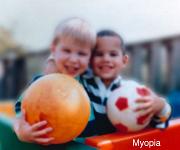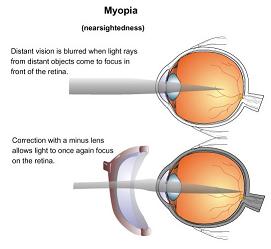Home > about eyes > Myopia
Myopia
Myopia or Shortsightedness
- Shortsightedness is when light entering the eye is focused incorrectly, making distant objects appear blurred.
- Shortsightedness is a type of refractive error of the eye.
- If you are shortsighted, you have trouble seeing things that are far away.
 Normal Vision |
 Vision with Myopia |
Causes, incidence, and risk factors
People are able to see because the front part of the eye bends (refracts) light and points it to the back surface of the eye, called the retina.
Shortsightedness occurs when the physical length of the eye is greater than the optical length.
This makes it more difficult for the eyes to focus light directly on the retina. If the light rays are not clearly focused on the retina, the images you see may be blurry.
Shortsightedness affects males and females equally. People who have a family history of shortsightedness are more likely to develop it. Most eyes with shortsightedness are healthy, but a small number of people with severe myopia
develop a form of retinal degeneration.
People are able to see because the front part of the eye bends (refracts) light and points it to the back surface of the eye, called the retina.
Shortsightedness occurs when the physical length of the eye is greater than the optical length.
This makes it more difficult for the eyes to focus light directly on the retina. If the light rays are not clearly focused on the retina, the images you see may be blurry.
Shortsightedness affects males and females equally. People who have a family history of shortsightedness are more likely to develop it. Most eyes with shortsightedness are healthy, but a small number of people with severe myopia
develop a form of retinal degeneration.
Symptoms
A shortsighted person sees close up objects clearly, but objects in the distance are blurred. Squinting will tend to make far away objects seem clearer.
shortsightedness is often first noticed in school-aged children or teenagers. Children often cannot read the blackboard, but they can easily read a book.
shortsightedness gets worse during the growth years. People who are shortsighted need to change glasses or contact lenses often. It usually stops progressing as a person stops growing in his or her early twenties.
Other symptoms may include:
- Eyestrain
- Headaches (uncommon)
Signs and tests
A shortsighted person can easily read the Jaeger eye chart (the chart for near reading), but has trouble reading the Snellen eye chart (the chart for distance).
A general eye examination, or standard ophthalmic exam may include:
- Eye pressure measurement (Tonometry)
- Refraction test, to determine the correct prescription for glasses
- Retinal examination
- Slit-lamp exam of the structures at the front of the eyes
- Test of colour vision, to look for possible colour blindness
- Tests of the muscles that move the eyes
- Visual acuity, both at a distance (Snellen), and close up (Jaeger)
Treatment
|
Wearing eyeglasses or contact lenses can help shift the focus of the light image directly onto the retina, producing a clearer image.
The most common surgery to correct myopia is LASIK. An excimer laser is used to reshape (flatten) the cornea, shifting the focus. Orthokeratology is the use of rigid gas-permeable contact lenses, normally worn only at night, to improve vision through the reshaping of the cornea. |

click for a larger image
|
Early diagnosis of shortsightedness is important, because a child can suffer socially and educationally by not being able to see well at a distance.
Complications
- Complications can occur in people who use contact lenses (corneal ulcers and infections)
- Complications of laser vision correction are uncommon, but can be serious
- People with myopia can, in rare cases, develop retinal detachments or retinal degeneration
Calling your health care provider
Call for an appointment if your child shows these signs, which may indicate a vision problem:
- Having difficulty reading the blackboard in school or signs on a wall
- Holding books very close when reading
- Sitting close to the television
Call for an appointment if you or your child is shortsighted and experiences signs of a possible retinal tear or detachment, including:
- Flashing lights
- Floating spots
- Sudden loss of any part of the field of vision
Prevention
There is no known way of preventing shortsightedness. Reading and watching television do not cause shortsightedness. In the past, dilating eye drops were proposed as a treatment to slow the development of shortsightedness in children, but they have never been proven effective.
The use of glasses or contact lenses does not affect the normal progression of myopia -- they simply focus the light so the shortsighted person can see distant objects clearly. Hard contact lenses will sometimes hide the progression of shortsightedness, but vision will still get worse "under" the contact lens.
References
- Olitsky SE, Hug D, Smith LP. Abnormalities of refraction and accommodation. In: Kliegman RM, Behrman RE, Jenson HB, Stanton BF, eds. Nelson Textbook of Pediatrics. 18th ed. Philadelphia, Pa: Saunders Elsevier; 2007:chap 619.
- Wilkinson PS, David EA, Hardten DR. LASIK. In: Yanoff M, Duker JS, eds. Ophthalmology. 3rd ed. St. Louis, Mo: Mosby Elsevier; 2008:chap 3.5.



